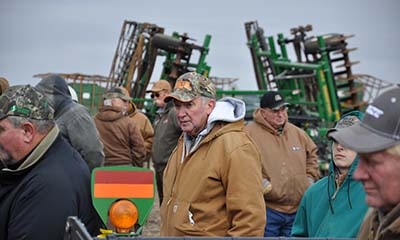
After years of planning, Rex and Judy Pitford in 2013 believed the time was right that they should retire, and a year later they did.
The farm economics were in their favor. Farm machinery prices were high, which would be favorable for selling their tractors, combines and other equipment. Also, the cattle market was strong for when it was time to sell their herd.
Also factoring into their decision were forecasts for lower crop prices in the years ahead and the pressure that would put on finances.

Rex Pitford attends his December 2014 farm auction. “If [grain prices] dropped very far, we would be mortgaging some ground to pay operating loans,” he says. (Photo: Sullivan Auctioneers LLC)
So, after 45 years of farming, the Missouri couple moved from active farmers to retired ones. In the spring when Rex Pitford would have been preparing ground and planting corn and soybeans, a tenant was farming his land instead.
“Just knowing it was going to be a completely different life was a big part of it,” he says of retirement. “When it was spring, it weighed on me a little bit. But I got over it.”
What helped him get “over it” was knowing he would have enough income to enjoy retirement.
Pitford had hoped to farm his 2,500 acres (730 of which they owned) near Williamstown until age 70. But he didn’t want his savings eaten up by sub-profit years of $3.50 corn and $9 soybeans. So, at 67, he walked away.
It’s a scenario that will likely play out for other farmers in coming years as prospects for higher grain prices seem dim.
“If [grain prices] dropped very far, we would be mortgaging some ground to pay operating loans,” he says.
Private and government forecasts say crop prices will stay low through 2016 and possibly into 2017.
The Pitfords did most of their own retirement planning. Their tax preparer walked them through the tax implications of receipts from auctioning off equipment in 2014 and selling their remaining grain. They carefully sold grain to lessen their tax bills.
Preserving cash and equity was key to ensure a comfortable retirement. The income from their 730 acres that they now rent out also will help cover the taxes.
Plan now to retire later
Farm management consultant Dick Wittman advises taking two to three years to plan for retirement and to involve specialists in tax planning, farm management and insurance. “Those who have competent tax advisers are sitting down three to five years before that target retirement date and really revising the marketing strategy to work through the equipment disposition process to avoid getting a big hit when they get out,” Wittman says.
One pitfall Wittman often sees is farmers not understanding how much untaxed grain they may have that can be a tax liability. “Anything you have raised but you have not sold is called unrealized gains and is taxable income the minute it is turned into cash,” he says.
For the Pitfords, in the past year they took a few vacations, improved their 730 acres and used some of their 2014 grain to pay taxes.
“We feel blessed. We got on it before the bank could say do this or do that. We did it on our own terms, and I’m thankful for that,” Pitford says. “I think we will be fine.”
About the Author(s)
You May Also Like




